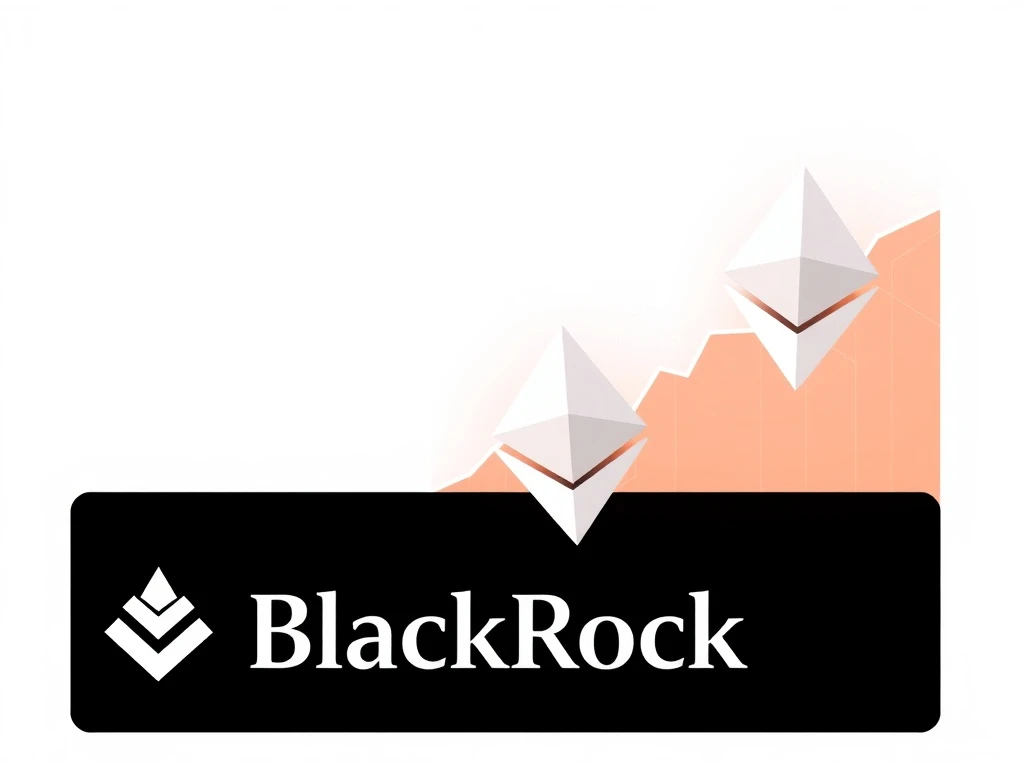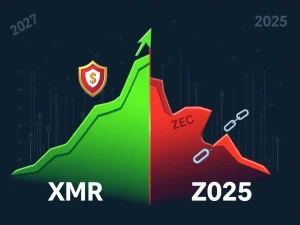Ethereum News Today: Unprecedented BlackRock Shift to ETH Fuels Altcoin Rally

In a move that has sent ripples across the cryptocurrency landscape, BlackRock Inc., the world’s largest asset manager, has made an unprecedented strategic pivot, significantly expanding its Ethereum exposure. This bold decision, involving the acquisition of 86,650 Ethereum units valued at an astounding $324.6 million, marks a definitive shift in institutional asset allocation, directly impacting the ongoing altcoin rally. For anyone following the latest Ethereum News, this development is a game-changer, underscoring a growing confidence in Ethereum’s long-term potential and its evolving role in the digital economy.
BlackRock Ethereum: A Monumental Institutional Shift
The financial world is buzzing with the news of BlackRock Ethereum acquisitions. This week alone, BlackRock purchased 86,650 ETH, worth $324.6 million, following a significant sale of $561 million in Bitcoin in June. This strategic reallocation suggests a deliberate move to capitalize on Ethereum’s evolving ecosystem and its appeal to institutional investors, signaling a potential diversification away from a Bitcoin-centric crypto strategy.
BlackRock’s commitment to Ethereum is not a sudden whim. Their iShares Ethereum Trust, which debuted in January 2024, has already attracted a staggering $20 billion in inflows, solidifying its position as the largest institutional Ethereum ETF. This substantial investment is rooted in several key factors that make Ethereum increasingly attractive to large-scale asset managers:
- The Ethereum 2.0 Transition (Proof-of-Stake): Ethereum’s successful shift to a more energy-efficient proof-of-stake (PoS) consensus mechanism has been a monumental achievement. This transition significantly reduces its carbon footprint (by over 99%), making it highly appealing to institutions with stringent ESG (Environmental, Social, and Governance) mandates. Furthermore, the ability to stake ETH for yield offers a new dimension of passive income potential, a concept familiar and attractive to traditional finance.
- Foundational Market Dominance: Ethereum remains the leading smart contract platform, powering the vast majority of the decentralized finance (DeFi) ecosystem and the non-fungible token (NFT) market. Its robust network effect, developer community, and widespread adoption in various Web3 applications continue to cement its role as a foundational blockchain, making it an attractive long-term holding.
- Unmatched Institutional Credibility: With over $10 trillion in assets under management, BlackRock’s public endorsement and substantial investment in Ethereum carry immense weight. This move amplifies confidence across crypto markets, providing a powerful signal to other traditional finance giants who might have been hesitant to enter the space. BlackRock’s entry legitimizes Ethereum further in the eyes of mainstream investors.
This strategic maneuver by such a prominent player sends a clear signal: Ethereum is not just a speculative asset but is rapidly maturing into an institutional-grade investment vehicle, poised for sustained growth and adoption.
The Accelerating Altcoin Rally: What’s Driving It?
BlackRock’s substantial ETH purchase isn’t happening in a vacuum; it coincides with a robust Altcoin Rally that has captivated the market. The ‘Altseason’ indicator, a metric that gauges the strength of altcoin performance relative to Bitcoin, has soared to 85. This is a strong sign of sustained capital inflows into non-Bitcoin cryptocurrencies, indicating a broadening of the crypto market beyond its traditional Bitcoin-dominated structure. Ethereum’s market dominance and its recent price performance are primary catalysts for this broader altcoin momentum.
Over the past two weeks, Ethereum’s market capitalization surged by an impressive $120 billion, reaching nearly $440 billion. This remarkable growth has created a positive ripple effect, cascading into other altcoins. Major players like Solana and Cardano have also registered double-digit returns this month, while newer projects across various sectors, from Layer 2 scaling solutions to decentralized applications, have seen significant gains. The increased ETH/BTC ratio further reflects a significant migration of capital from Bitcoin into Ethereum and other alternative assets, suggesting a strategic diversification by investors seeking higher growth potential.
The narrative of altcoins as mere speculative assets is evolving rapidly. With major institutions like BlackRock diversifying their crypto portfolios beyond Bitcoin, altcoins are gaining unprecedented legitimacy. This rally is fueled by a dynamic combination of factors:
- Technological Advancements: Continuous innovation across various blockchain networks, including significant progress in layer-1 scalability, layer-2 solutions (like Arbitrum and Optimism on Ethereum), and cross-chain interoperability, enhancing the overall efficiency and utility of the crypto ecosystem.
- Explosive Ecosystem Growth: The relentless expansion of decentralized finance (DeFi) protocols, burgeoning non-fungible token (NFT) marketplaces, and the emergence of new Web3 applications on different chains are driving tangible utility and increasing demand for their native tokens.
- Shifting Market Dynamics: While Bitcoin remains the undisputed market leader, its dominance has slightly receded in recent months, creating an opportune environment for more capital to flow into promising altcoins with strong fundamentals and innovative use cases.
This confluence of institutional interest, technological maturity, and expanding utility is transforming the altcoin market into a vibrant and increasingly attractive segment of the digital asset landscape.
Understanding ETH Price Dynamics and Market Impact
The impact of BlackRock’s actions on the ETH Price has been immediate and significant. By July 24, Ethereum’s price had climbed a remarkable 18% to $3,750. This surge is not merely a reflection of BlackRock’s direct buying pressure but also the powerful ripple effect it creates, encouraging a broader spectrum of institutional and retail investors to increase their Ethereum exposure. This institutional validation often acts as a strong catalyst, building momentum and confidence across the market.
Key metrics highlighting Ethereum’s current market strength and its trajectory:
| Metric | Value/Change (July 2025) | Significance |
|---|---|---|
| ETH Price | Up 18% to $3,750 | Demonstrates strong buying interest and robust institutional confidence, pushing the asset towards new highs. |
| Market Capitalization | Surged $120 billion (to ~$440 billion) | Reflects a substantial influx of capital, expanding Ethereum’s overall market footprint and influence. |
| ETH/BTC Ratio | Rising | Indicates a strategic shift of capital from Bitcoin into Ethereum, signaling a preference for ETH’s growth potential. |
| Cumulative ETF Inflows | Exceeding $7.7 billion | Highlights the escalating institutional appetite for regulated Ethereum exposure through ETF products. |
| BlackRock Ethereum Trust Weekly Volume | $3.1 billion (100% lead) | Underscores BlackRock’s dominant position and significant influence within the institutional Ethereum market. |
This sustained upward trajectory in ETH price, coupled with robust trading volumes in institutional products, paints a clear picture of a cryptocurrency gaining solid and undeniable footing in mainstream finance. The momentum suggests a long-term re-evaluation of Ethereum’s intrinsic value.
The Broader Landscape of Institutional Crypto Adoption: Who Else is In?
BlackRock’s groundbreaking move is not an isolated event; it’s part of a much larger, accelerating trend of Institutional Crypto adoption that is reshaping the financial world. The pivotal approval of spot Ethereum ETFs in mid-2024 has been a game-changer, pushing total crypto ETF assets beyond an impressive $30 billion. This regulatory clarity has effectively opened the floodgates, providing traditional investors with a familiar, regulated, and accessible pathway to gain exposure to digital assets without the complexities of direct cryptocurrency ownership or self-custody.
Beyond BlackRock, other major players and trends are converging to solidify crypto’s place in institutional portfolios:
- Vanguard’s Expected Entry: Given the surging demand for diversified crypto exposure and the competitive landscape, rival asset manager Vanguard, known for its conservative approach, is widely expected to eventually follow suit with its own crypto offerings, further legitimizing the asset class.
- Growing Private Wealth Firm Interest: Smaller but influential private wealth firms are also actively increasing their digital asset allocations. For instance, World Liberty Financial recently acquired an additional 3,473 Ethereum units worth $13 million, boosting their total Ethereum reserves to a substantial 73,616 ETH. This demonstrates a broader acceptance and integration of crypto into diversified wealth management strategies.
- Shifting Retail Investor Sentiment: The institutional push is paralleled by a significant shift in retail investor sentiment. A recent Gallup poll revealed that a remarkable 45% of U.S. investors now view cryptocurrencies as long-term investments. This growing belief in crypto’s enduring value from both institutional and retail fronts provides a strong foundation for sustained demand.
Ethereum currently accounts for a significant 28% of all crypto ETF assets under management, underscoring its critical and growing role in diversified institutional portfolios. This widespread adoption suggests that digital assets are increasingly seen as a legitimate and integral part of a balanced investment strategy, moving beyond the realm of niche, speculative plays to become a recognized asset class.
Navigating the Volatility: Risks and Rewards of the Altcoin Surge
While the current altcoin rally presents significant opportunities for substantial returns, it’s crucial for investors to acknowledge and understand the inherent volatility risks. The rapid accumulation of altcoin exposure has led to a dramatic surge in futures open interest across major altcoins, including Ethereum, Solana, XRP, and Dogecoin. This figure has climbed an astounding 69% to $44 billion since early July. This indicates a significant increase in leveraged positions, where traders borrow capital to amplify their bets, making the market more susceptible to rapid price swings. Daily trading volumes have consistently remained above two-standard-deviation levels for 12 consecutive sessions, signaling unusual and heightened market activity that often precedes periods of increased volatility.
Key risk indicators and considerations for investors:
- Leveraged Long Positions and Funding Fees: The surge in leveraged long positions has incurred $32.9 million in cumulative funding fees over the past month. Funding fees are payments exchanged between long and short traders in perpetual futures contracts to keep the contract price close to the spot price. High funding fees indicate that a majority of traders are betting on price increases, making the market vulnerable to a cascade of liquidations if prices unexpectedly drop. This level of funding fees is nearing those seen during Bitcoin’s March 2025 peak, a period often followed by corrections.
- Market Coupling and Bitcoin Dominance: Analysts caution that the tight coupling between Ethereum and other altcoins means that a significant falter in Ethereum’s momentum could amplify downside risks across the broader altcoin market. Despite Ethereum’s growing influence, Bitcoin still commands a substantial 64% of the total crypto market value. A major correction in Bitcoin could still exert downward pressure on altcoins, even those with strong fundamentals.
- Regulatory Uncertainties: Despite recent ETF approvals, the global regulatory landscape for cryptocurrencies remains fragmented and subject to rapid change. Unforeseen regulatory actions or stricter enforcement could introduce significant challenges and market uncertainty.
Despite these cautions, the momentum of the altcoin rally shows no immediate signs of slowing. Over $216 billion in Ethereum inflows since July alone mark one of the largest altcoin surges in history, reflecting strong conviction among a diverse range of investors. The long-term narrative for Ethereum and other altcoins remains compelling, driven by innovation and utility.
Actionable Insights for Investors
Given the current market dynamics, what does BlackRock’s strategic pivot mean for you? Here are some actionable insights:
- Diversify Your Portfolio: While Bitcoin remains a cornerstone, consider diversifying into Ethereum and other established altcoins with strong use cases, especially those benefiting from institutional interest.
- Understand the Fundamentals: Don’t just chase price pumps. Research the underlying technology, team, and ecosystem of any altcoin you consider. Ethereum’s robust DeFi and NFT sectors are key to its long-term value.
- Risk Management is Key: The altcoin market, while offering high rewards, comes with high volatility. Only invest what you can afford to lose and consider dollar-cost averaging to mitigate price fluctuations. Be aware of leveraged positions and their associated risks.
- Stay Informed on Institutional Moves: Keep a close eye on announcements from major asset managers like BlackRock and Vanguard. Their investment decisions can be powerful indicators of market trends and legitimacy.
- Monitor Regulatory Developments: Regulatory clarity is a significant driver of institutional adoption. Stay updated on global regulatory changes that could impact the crypto market.
The Future Outlook: Ethereum’s Enduring Appeal
BlackRock’s strategic bets, coupled with the broader trend of institutional and retail adoption, signal growing confidence in Ethereum’s future. Its foundational role in DeFi, NFTs, and the broader Web3 ecosystem, combined with its successful transition to a more sustainable proof-of-stake model, positions it as a cornerstone of the digital economy. This evolution from a niche tech asset to a recognized financial instrument is a testament to its resilience and adaptability.
While market volatility and evolving regulatory frameworks will always be factors in the dynamic crypto space, the increasing integration of digital assets into traditional finance suggests a long-term trajectory of growth and maturation. The unprecedented institutional embrace of Ethereum marks a significant milestone, hinting at a future where digital assets play an even more central role in global finance. Investors and enthusiasts alike will be watching closely to see how this powerful shift continues to shape the future of cryptocurrencies.
Frequently Asked Questions (FAQs)
Q1: Why is BlackRock investing so heavily in Ethereum now?
BlackRock’s increased investment in Ethereum is driven by several factors, including Ethereum’s successful transition to the energy-efficient proof-of-stake model (Ethereum 2.0), its foundational role in the rapidly growing DeFi and NFT sectors, and the firm’s belief in its long-term potential as an institutional-grade asset. The firm also likely sees a strategic opportunity to diversify its crypto holdings beyond Bitcoin, leveraging Ethereum’s unique utility.
Q2: What is the significance of the ‘Altcoin Rally’ and ‘Altseason Indicator’?
An ‘Altcoin Rally’ refers to a period where cryptocurrencies other than Bitcoin (altcoins) experience significant price increases, often outperforming Bitcoin. The ‘Altseason Indicator’ reaching 85 suggests that a substantial amount of capital is flowing into altcoins, indicating strong market momentum and investor confidence in these alternative digital assets, with Ethereum often leading the charge.
Q3: How have Spot Ethereum ETFs impacted institutional adoption?
The approval of Spot Ethereum ETFs has been crucial for institutional adoption. These ETFs provide a regulated, familiar, and accessible investment vehicle for traditional financial institutions and investors to gain exposure to Ethereum without directly holding the cryptocurrency. This has led to billions in inflows, increased liquidity, and significantly boosted the legitimacy of Ethereum as an asset class within mainstream finance.
Q4: What are the main risks associated with the current altcoin surge?
The primary risks include increased market volatility due to surging futures open interest and highly leveraged positions, which can amplify price swings and lead to rapid liquidations. There’s also the risk of a market correction if Ethereum’s momentum falters, potentially impacting other tightly coupled altcoins. Furthermore, the evolving and often uncertain regulatory landscape remains a persistent challenge for the entire crypto market.
Q5: Is BlackRock completely shifting away from Bitcoin?
While BlackRock has recently sold a significant amount of Bitcoin and reinvested in Ethereum, it does not necessarily mean a complete shift away from Bitcoin. It indicates a strategic diversification and a growing confidence in Ethereum’s distinct value proposition and growth potential. BlackRock likely views both Bitcoin and Ethereum as crucial components of a diversified crypto portfolio, each serving different purposes and offering unique investment opportunities.
Q6: What is Ethereum 2.0 and why is it important for institutional investors?
Ethereum 2.0, more accurately referred to as the series of upgrades including ‘The Merge’, signifies Ethereum’s transition from a proof-of-work (PoW) to a proof-of-stake (PoS) consensus mechanism. This is important for institutional investors because it drastically reduces Ethereum’s energy consumption (making it more environmentally friendly), introduces the potential for staking rewards, and lays the groundwork for future scalability improvements, all of which align with institutional investment criteria for sustainability, yield, and long-term viability.










